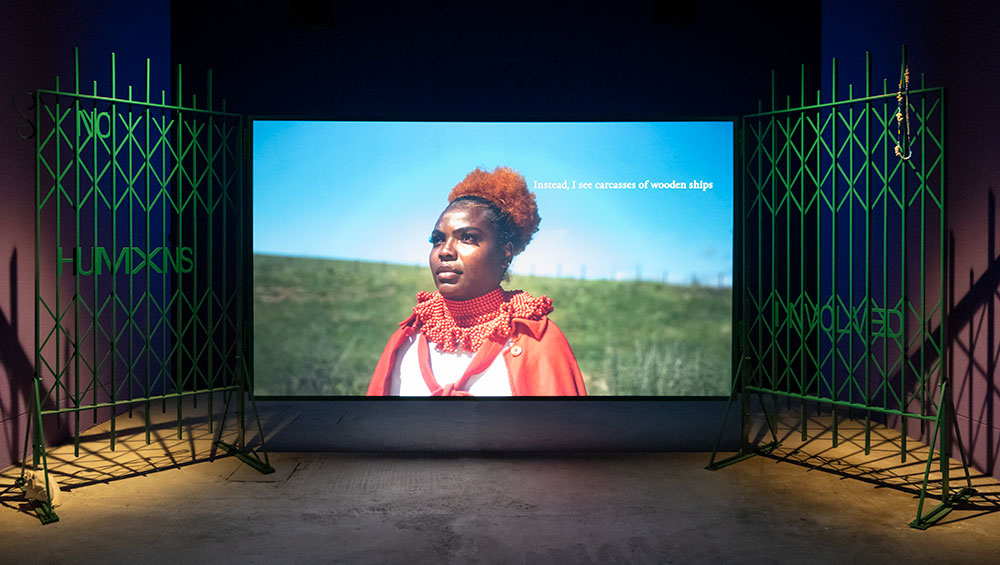
Alberta Whittle, Lagareh – The Last Born, 2022. Installation view ‘deep dive (pause) uncoiling memory’, Scotland + Venice, 59th Venice Biennale, 2022. Co-commissioned and produced by Scotland + Venice and Forma for the 59th International Art Exhibition – La Biennale di Venezia. Courtesy of the artist and The Modern Institute / Toby Webster Ltd., Glasgow. Photo: Cristiano Corte.
Scottish National Gallery of Modern Art (part of the Edinburgh Art Festival 2023)
1 April 2023 – 7 January 2024
by CHRISTIANA SPENS
Four years ago, at Dundee Contemporary Arts, I saw the exhibition How Flexible We Can Make the Mouth, in which the Barbadian-Scottish artist Alberta Whittle explored her heritage and the legacy of Scottish involvement in the British empire through a powerful exhibition that used film, etching, textiles and installation to provide an adventurous, immersive experience. She presented a voyage into complex ideas and communal legacies, which were at times harrowing – the audience’s chairs were shackled to the ground with large, heavy chains, and a scale model of a “chattel house,” a mobile wooden home occupied by working-class people in Barbados, appeared to be sinking into the floor.
This last installation is now part of Whittle’s solo exhibition at the Scottish National Gallery of Modern Art in Edinburgh (part of the Edinburgh Art Festival 2023), boldly titled Create Dangerously, in which the artist brings together and develops the elements of her practice for which she is now acclaimed. The past three years have seen major successes for Whittle: in 2020, she won the Frieze Artist Award and a Turner Prize bursary (the prize was cancelled that year due to the Coronavirus pandemic); in 2022, her work was selected for the British Art Show 9 and she represented Scotland at the Venice Biennale.
.jpg)
Alberta Whittle, Taking a leap toward the ancestors (remembering G), 2022. Raffia, acrylic, cotton, doillies, wool, felt, Florida Water and Bay Rum on linen, 153 x 153 x 20 cm (60 1/4 x 60 1/4 x 7 7/8 in). Courtesy of the artist and The Modern Institute / Toby Webster Ltd., Glasgow. Photo: Patrick Jameson.
As her career has progressed, she has deepened and developed her vision of a reckoning with the colonialist past, both personally and communally, the artist guiding the way. While the harrowing, challenging elements of her work are inescapable and crucial, she manages to keep alive a sense of hope that, by acknowledging these realities communally, we may find solutions and so create a stronger, fairer future.
Titling this exhibition Create Dangerously acknowledges the boldness and the risks of such political, pointed and rousing art. The phrase is taken from a book that has inspired Whittle, the Haitian American writer Edwidge Danticat’s 2010 work Create Dangerously: The Immigrant Artist at Work. Danticat, in turn, had taken the title from the book by Albert Camus. Thus, Whittle transforms it into an invitation to the audience more widely to become actively involved in resistance and social change through art and beyond. She takes a compassionate, caring attitude to this change, however, stressing it is important that we heal intergenerational trauma and the legacy of colonialism through love, kindness and care. We can acknowledge Scotland’s complicity in the structures of empire and white supremacy, for instance — and indeed parallel cases in England, America, Australia and Europe – and yet concurrently hold up new visions for a fair future in which the harms of these histories hurt and persist less violently. It is through honest appraisal and engagement with the past, but also a joyful imagining of a free future, that we can genuinely build a better society and come to some peace in our own lives too. Even in the present space of the exhibition, Whittle encourages an ethics of care, with comfortable seating for the audience, handmade quilts that can be used by visitors, and an atmosphere that is as inviting as it is confrontational – no easy feat!
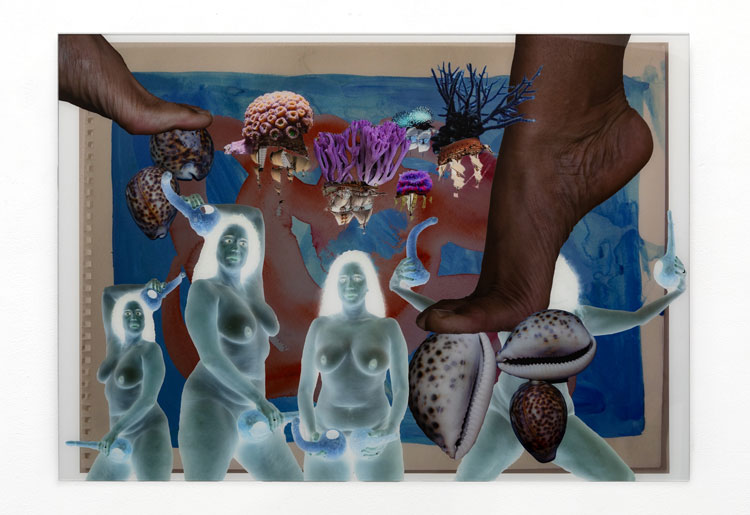
Alberta Whittle, Dreaming Other-ways, 2021. C-type digital collage, diasec mounted on aluminium, 64.1 x 90.3cm (25 1/4 x 35 1/2). Courtesy of the artist and The Modern Institute / Toby Webster Ltd., Glasgow. Photo: Patrick Jameson.
Aesthetically, part of the key to understanding the state we find ourselves in is through collage that allows for these various, at times conflicting elements – not only literal collage of textiles, but also as a whole body of work, in collaging so many different materials, techniques and art forms in these connected, overlapping spaces.
This entanglement and its inherent confusion, the contradictions of oppression and liberation, memory and vision, nostalgia and harsh escape, come together to express the complexity of living with a legacy and world that is itself characterised by contradiction, confusion, gaps of knowledge and absence of people. There is a rush of imagery, material, colour — and a sense of grasping through chaos for something of meaning, a narrative somehow underlying all these subjective, changing, even ethereal creations.
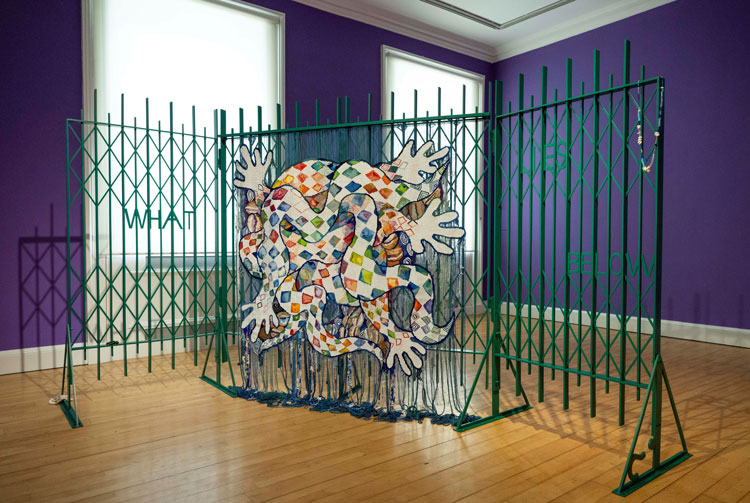
Alberta Whittle, Tapestry woven by Dovecot Studios. Cotton, linen, whaling rope, fishing rope, Venetian trading beads, children's hair clips, manillas, and cowrie shells; steel. National Galleries of Scotland. Purchased with assistance from Lesley Knox 2023. Co-commissioned by Scotland+Venice and Dovecot Studios, Edinburgh.
Photo: Neil Hanna.
This show also includes Whittle’s major Venice Biennale work, the film Lagareh: The Last Born. Here, Whittle presents a collage of footage: the recent story of Sheku Bayoh, the 31-year-old man who died after being restrained by police in Kirkcaldy, Fife, in 2015, alongside footage on the history of slavery, as well as other strands in which a dancer is entwined with a snake and another dancer bears two machetes. Then there is a Mandinkan “praise song” for Bayoh sung by the musician Kumba Kuyateh in a London court room, and a queer couple talking about the future they want for their children. Lastly, the film presents a roll call of people of colour who have allegedly died at the hands of the police in the UK and the words: “We will remember.” This is a memorial, an elegy and a manifesto for real change. It is heartbreaking and rousing.
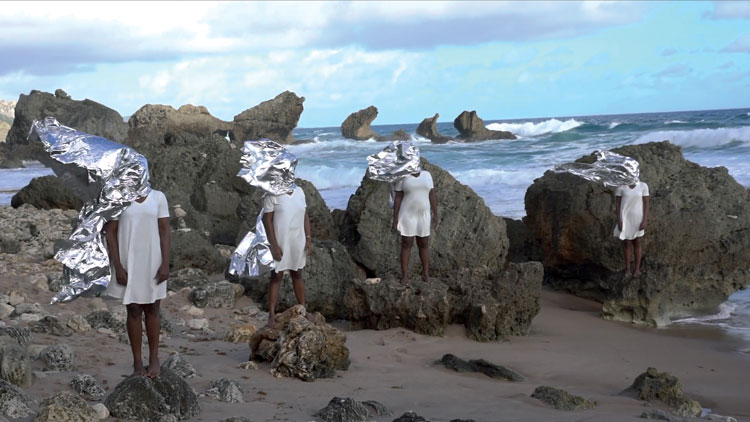
Alberta Whittle, Holding the Line: A refrain in two parts, 2021 (film still). Courtesy of the artist and The Modern Institute / Toby Webster Ltd., Glasgow.
Lagareh is now also recontextualised with the artist’s other recent works, including the film Holding the Line: A Refrain in Two Parts, which considers the treatment of people of colour during the pandemic. This film also uses collage, with recent footage of recent political events, from a black man being stopped and searched during lockdown to police in riot gear being aggressive towards Black Lives Matter activists, alongside film capturing voice, reflective ritual and dance.
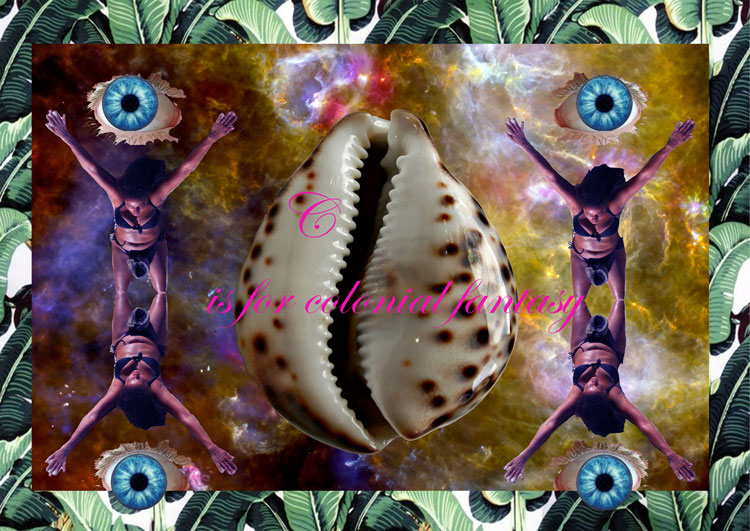
Alberta Whittle, C is for Colonial Fantasy, 2017. C-type digital collage, diasec mounted on aluminium 61 x 91.4 cm (24 x 36 in). Courtesy of the Artist and The Modern Institute / Toby Webster Ltd., Glasgow.
The rooms of the gallery are painted in mesmerising purples, greens and blues, presenting a series of watercolours, oil paintings, digital collages, sculptures and textile pieces. The entire exhibition, then, is a collage, with layer on layer of artwork coming together in a cohesive expression of unrest, anger, heartbreak, desolation, desire and hope. As with her previous exhibition at the Dundee Contemporary Arts, and installations and works since, Whittle’s latest exhibition presents such strength and love, a real delivery of what it is to communally confront and heal from a fractured, tragic past. The key here is love and care, alongside radical honesty. Whittle is courageous and liberating in her work, which is so necessary and so inspiring.